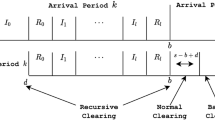Abstract
Real-time packet traffic is characterized by a strict deadline on the end-to-end time delay and an upper bound on the information loss. Due to the high correlation among consecutive packets, the individual packet loss does not well characterize the performance of real-time packet sessions. An additional measure of packet loss is necessary to adequately assess the quality of each real-time connection. The additional measure considered here is the average number of consecutively lost packets, also called the average packet gap. We derive a closed form for the average packet gap for the multiclassG/G/m/B queueing system in equilibrium and show that it only depends on the loss behavior of two consecutive packets. This result considerably simplifies the monitoring process of real-time packet traffic sessions. If the packet loss process is markovian, the consecutive packet loss has a geometric distribution.
Similar content being viewed by others
References
F. Baccelli and P. Brémaud,Palm Probabilities and Stationary Queues, Lecture Notes in Statistics, vol. 41 (Springer, Heidelberg, 1987).
M. Kac, On the notion of recurrence in discrete stochastic processes, Bull. Amer. Math. Soc. 53 (1947) 1002–1010.
J.F. Kurose, M. Schwartz and Y. Yemini, Controlling window protocols for time constraint communication in multiple access networks, IEEE Trans. Commun. COM-36 (1988) 41–49.
A.A. Lazar, G. Pacifici and J.S. White, Real-time traffic measurements on MAGNET II, IEEE Trans Sel. Areas Commun. SAC-4 (1990) 467–483.
A.A. Lazar, A.T. Temple and R. Gidron, MAGNET II: A metropolitan area network based on asynchronous time sharing, IEEE Trans. Sel. Areas Commun. SAC-8 (October 1990).
S. Li, Study of information loss in packet voice systems, IEEE Trans. Commun. COM-37 (1989) 1192–1202.
S. Mazumdar and A.A. Lazar, Monitoring integrated networks for performance management, in:Proc. 1990 Int. Conf. on Communications, Atlanta, GA (1989).
V. Ramaswami and W. Willingwer, Efficient traffic performance strategies for packet multiplexers, Comp. Networks ISDN Syst. 20 (1990) 401–407.
N. Yin, S. Li and T. Stern, Performance analysis of a priority-oriented packet voice system, in:Proc. IEEE INFOCOM'87, San Francisco, CA (1987) pp. 1054–1062.
N. Yin, S. Li and T. Stern, Congestion control for packet voice, CTR Technical Report 78, Center for Telecommunications Research, Columbia University, New York (1988).
Author information
Authors and Affiliations
Rights and permissions
About this article
Cite this article
Ferrandiz, J.M., Lazar, A.A. Monitoring the packet gap of real-time packet traffic. Queueing Syst 12, 231–242 (1992). https://doi.org/10.1007/BF01158800
Received:
Revised:
Issue Date:
DOI: https://doi.org/10.1007/BF01158800




